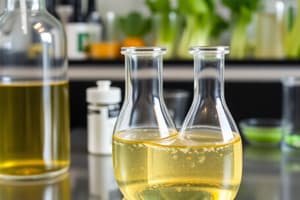Podcast
Questions and Answers
What is the main difference between aerobic respiration and fermentation?
What is the main difference between aerobic respiration and fermentation?
- Fermentation results in the release of carbon dioxide, while aerobic respiration does not.
- Aerobic respiration requires oxygen, while fermentation does not. (correct)
- Fermentation involves breaking down glucose, while aerobic respiration does not.
- Aerobic respiration releases more energy than fermentation.
During which type of respiration is less energy released by the breakdown of glucose?
During which type of respiration is less energy released by the breakdown of glucose?
- Cellular respiration
- Fermentation (correct)
- Aerobic respiration
- Anaerobic respiration
What role does oxygen play in the process of respiration?
What role does oxygen play in the process of respiration?
- Triggers the release of waste gases
- Helps in releasing energy from glucose (correct)
- Aids in the breakdown of carbon dioxide
- Allows for the synthesis of glucose
Which gas is considered a waste product during cellular activity?
Which gas is considered a waste product during cellular activity?
How do our lungs facilitate the absorption of oxygen and disposal of carbon dioxide?
How do our lungs facilitate the absorption of oxygen and disposal of carbon dioxide?
Flashcards are hidden until you start studying
Study Notes
Respiration is the process by which animals obtain oxygen from their environment and release carbon dioxide. It can occur through two different methods, aerobic and fermentation, depending on whether oxygen is present during metabolism. Aerobic respiration involves cells breaking down glucose using oxygen and releasing energy. Fermentation does not involve oxygen, so less energy is released by the breakdown of glucose. This type of metabolic pathway occurs when there isn't enough oxygen available. When we breathe in, our lungs bring air into our bodies where it reaches our bloodstream, allowing us to absorb oxygen and expel carbon dioxide. Oxygen helps our body produce energy while carbon dioxide is waste gas produced during cellular activity. Additionally, during photosynthesis plants create oxygen, providing the atmosphere with more of this vital element for animal life. The process of respiration has been studied extensively over time, particularly its chemical aspects, such as enzyme reactions and diffusion of gases within organisms. In summary, the processes of respiration allow living things to get rid of waste products like carbon dioxide and receive essentials like oxygen to live healthy lives.
Studying That Suits You
Use AI to generate personalized quizzes and flashcards to suit your learning preferences.




